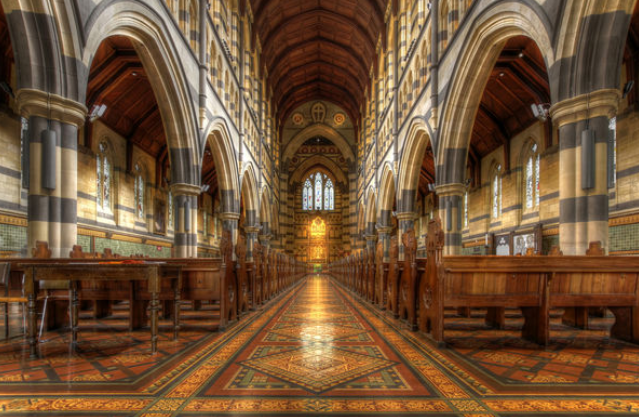
For a country with a comparatively short architectural history Australia has a remarkable number of fine buildings. A string of distinguished architects designed them, working comfortably in a repertoire of Western styles from Georgian and Classical Revival to Art Deco and even Bauhaus to give this country some of the most notable buildings of their kind in the world. I do not exaggerate.
The magnificent dark-and-light-stone-banded interior of St Paul’s Cathedral in Melbourne (above) is the most accomplished example anywhere of the work of William Butterfield, perhaps the greatest of the English Gothic Revivalists; St John’s Cathedral in Brisbane—completed, almost incredibly, at the end of the secularised twentieth century—testifies to the genius of a later Gothicist, J.L. Pearson. That neither of these architects was Australian (one shouldn’t have to say this but there is a cult of faux-patriotism, much fostered by the ABC and media, that construes Australian as a superlative) in no way derogates from their buildings as local structures nor from the achievements of locally practising masters of Gothic revival and Neo-Gothic such as the Blackets, William Wardell, J. Horbury Hunt and Alexander North. Then there are the dozens of other notable cathedrals and churches in all states, and the host of parliamentary, government, civic, academic, commercial and cultural buildings throughout the land, and, as Robin Boyd pointed out, an eclectic range of private houses in town and country. Whether Australia is still the lucky country in the sense that Donald Horne snidely dubbed it in 1964 is a moot point, but there is no doubt at all that it remains supremely fortunate in its heritage of architecture.
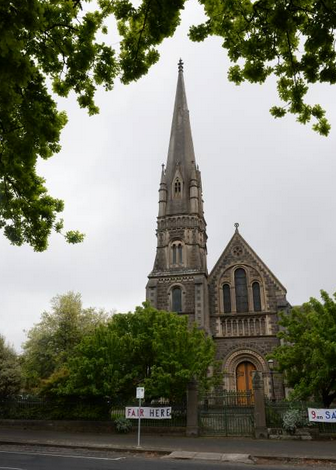 Among these buildings it is the churches that we should especially value. First, because it is all but inconceivable that places of worship will ever again be built here on such a scale. St John’s in Brisbane and the soaring Medieval-inspired Catholic cathedral in Bendigo were anachronisms even as their spires arose. Second, because churches are vulnerable. The need for most of them, particularly those built to hold hundreds of worshippers, has long since ebbed along with Matthew Arnold’s sea of faith, and they are at risk of demolition or internal subdivision into revenue-producing offices with a small “worship space” in a corner or, worst of all, profanation through conversion into flats and “town houses” with trapezoidal windows cut into their walls and layers of solar panels on their roofs. The fate of perhaps a score of unused churches in the once strongly Presbyterian and Catholic Victorian provincial city of Ballarat is a chilling foretaste of what could soon be happening everywhere. That de-Christianised city’s principal Presbyterian church, St Andrew’s, (pictured above) and built like the others largely on the proceeds of gold and wool, whose spire is one of the city’s few landmarks, is about to be “redeveloped” as apartments; the Uniting Church, to which its ownership devolved, having declined to sell it to the Anglicans as a cathedral because, it has been reported locally, the developer offered a higher price.
Among these buildings it is the churches that we should especially value. First, because it is all but inconceivable that places of worship will ever again be built here on such a scale. St John’s in Brisbane and the soaring Medieval-inspired Catholic cathedral in Bendigo were anachronisms even as their spires arose. Second, because churches are vulnerable. The need for most of them, particularly those built to hold hundreds of worshippers, has long since ebbed along with Matthew Arnold’s sea of faith, and they are at risk of demolition or internal subdivision into revenue-producing offices with a small “worship space” in a corner or, worst of all, profanation through conversion into flats and “town houses” with trapezoidal windows cut into their walls and layers of solar panels on their roofs. The fate of perhaps a score of unused churches in the once strongly Presbyterian and Catholic Victorian provincial city of Ballarat is a chilling foretaste of what could soon be happening everywhere. That de-Christianised city’s principal Presbyterian church, St Andrew’s, (pictured above) and built like the others largely on the proceeds of gold and wool, whose spire is one of the city’s few landmarks, is about to be “redeveloped” as apartments; the Uniting Church, to which its ownership devolved, having declined to sell it to the Anglicans as a cathedral because, it has been reported locally, the developer offered a higher price.
This essay appears in May’s Quadrant.
Click here to subscribe
But there is another perpetual threat to surviving churches and this comes from the people who actually use them, or more specifically and usually, the professional clergy. And sad to say, the threat is strongest in the body that owns the largest number of Australia’s architecturally distinguished and substantial churches, the Roman Catholic Church. In fact there is scarcely one Catholic church in the whole country that has not been to a greater or lesser extent altered—vandalised would be in most cases the more precise word. From outside they look just as when they were built, but inside, no. Not since the altar-smashing Protestant reformers in the sixteenth century, or indeed the secularisers of the French Revolution, has there been destruction of ecclesiastical fittings and objets d’art on such a scale. And as with the reformers and the revolutionaries, the iconoclasm was justified on the grounds of progress, in this case progress towards the brave new Church of the future, as envisaged in the destroyers’ interpretation of what can now be seen as a supreme exercise in ecclesiastical folly, the Second Vatican Council (1962–65), usually referred to as Vatican II.
Vatican II mandated certain changes to the Catholic liturgy. In themselves these were modest enough—a simplified Mass, use of the vernacular—but they were appropriated by a powerful, partly German-influenced protestantising party in the Church that regarded the Council as an opportunity for the Catholic Church to undergo its own Reformation. These latter-day reformers saw themselves as “filled” with “the spirit of Vatican II”, a spirit that they spruiked, somewhat prematurely, as a “new Pentecost” (its real results can be observed all around us now, in the demographically reduced status of the Catholic Church in the West).
Not at their least energetic here in Australia, the protestantisers seized on the Council’s liturgical revisions as a justification for much vaster changes to the church buildings in which the ritual novelties were to be enacted. The typical Catholic sanctuary with its altar and tabernacle and six candlesticks was not congenial to the protestantisers who, as the ecclesiastical equivalent of secular leftists, manoeuvred themselves as leftists always do into positions of authority from which they could impose their own “vision”. They wanted bare sanctuaries—or no sanctuaries at all—in supposed emulation of primitive Christians in the catacombs, with the altar pushed out into the middle of the congregation and reduced to a table like an ironing board or butcher’s block, on which their version of the Mass, interpreted by them not as a sacrifice but as a communal agape, could be celebrated with everyone gazing on (a) to show that it wasn’t the priest alone who celebrated the liturgy and (b) to make sure the laity weren’t just sitting there letting their minds wander but (a favourite phrase) “actively participating”.
To this intent existing churches had to be “reordered”, generally with little concern for the integrity of their architecture or fittings. Architectural or artistic beauty was no protection against alteration and removal; the reorderers, like their sixteenth-century predecessors, prioritised function. It was a field in which the United States led the Catholic world. The high priest of American reorderers, Father Richard Vosko, author of God’s House Is Our House: Re-imagining the Environment for Worship, a manifesto of radical church renovation, is quoted as describing pre-Vatican II American cathedrals (of which he has worked on thirteen) and other churches as “designed to house a liturgy of a different age and genre—a different, pre-Vatican II understanding of what liturgy is”. Defective to protestantisers on that account, these historic buildings had to be dragged metaphorically kicking and screaming into the ecclesiologically enlightened late twentieth century. Churches were to become, to paraphrase Le Corbusier, machines for worship.
Sometimes in church porches or in parish histories you will find a photograph of the church as it was before about 1968. Comparing that with its present appearance reveals that in not a few cases a clean sweep has been made of the former fittings and furnishings—altars, pulpits, communion rails, statues, decorative floor tiles, even old-fashioned pews with kneelers. Comfy chairs on carpeted floors have been substituted for the pews and tiles, wooden tables and lecterns have replaced altar and pulpit. Some churches have been reoriented in plan with the altar aligned with one of the side walls. (This is called “horizontal” orientation and expresses, according to one notable reorderer, “God’s presence in and with the community”, as opposed to the conventional “vertical” orientation with God at the far end. Obviously to those who think like this God is not beyond space and time.) Although no great aesthetic merit can be claimed for some of the fittings removed, the replacements are usually worse, having been designed in the infantile “contemporary” idiom of forty years ago. Worse than the loss of fittings is the architectural loss deriving from the hollowing out, the emptying of a church whose altar and other furnishings were components of its logical form. The damage is beyond calculation.
All this took place for the most part without the disapproval of bishops and others who could have stopped it, they being themselves in many cases (the late Archbishop Guilford Young of Hobart springs to mind) as zealous as their clergy in their promotion of “the spirit of Vatican II”. The desire for change under the influence of the new reformers spread with astonishing speed. Priests in particular who had been brought up in and seemed happy with the “old” Catholicism embraced the new with gusto. Real opposition came largely from the laity. There were plenty of objections to the changes from individual churchgoers, especially from those whose families had donated the discarded objects, but these objections of course were dismissed as “reactionary” and as not being on-message with what “the spirit was saying to the Church”.
The high-water mark of reorderings was reached in the late 1990s (if one seeks a peak example it could be the removal in that decade of the tempietto, the canopy under which the Blessed Sacrament was exposed for adoration, and downgrading of the high altar in what was once the many-candled national shrine of traditional Catholic eucharistic devotion, St Francis’s church in Melbourne). With the new century the tide of destruction slowed, partly of course because there wasn’t much left to reorder. In the past two decades there has been some hope, even indication, that with natural changes in fashion, and under the conservative influence of Popes John Paul II and Benedict XVI in recovering Catholic identity, and above all by the ageing and retirement of the “spirit of Vatican II” enthusiasts, the worst of the vandalism was over.
In the United States, which is always ahead of Australia in fashion, and where untold damage had been done, the tide had demonstrably turned, and a not inconsiderable number of gifted architects such as Duncan Stroik (professor of architecture at Notre Dame University), James McCrery, David Meleca, Steve Baker and the venerable firm of Cram and Ferguson were being commissioned to undo the radical reorderings (for which traditionalists had invented the term “wreckovation”) and restore Catholic churches to a recognisably Catholic appearance, as well as to build an astonishing number of new churches. The work of these architects, much of it remarkably accomplished and beautiful in an historical way, can be seen on their abundantly illustrated websites. Their influence is at last beginning to be felt in Australia. Sidney Rofe, architect of the Benedict XVI Retreat Centre at Grose Vale outside Sydney, is one designer forging a reputation for his tradition-inspired work. Edward O’Hanlon is another. At the same time there is evidence that the battle here is far from won and there is life in the wreckovators yet.
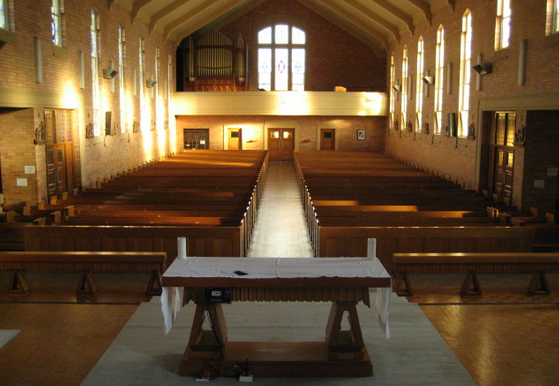
St Vincent de Paul’s, a large cream-brick church built in 1959 in the green-gardens Melbourne suburb of Strathmore, is described on the Victorian Heritage Database as “a fine and intact example of the work of Cyril C. Kelly, a prolific Catholic architect whose designs for churches and monasteries are characterised by a hybrid conservative/contemporary style”. Intact it might have been when that was written (as pictured above) but it certainly isn’t now. The interior of the chancel, with its imposing altar and what the heritage report notes as its “unusual baldacchino”, was gutted in a recent renovation and the altar and baldacchino discarded. They were replaced by a pipe organ standing bang in the middle of the chancel where the altar used to be. An insignificant altar stands in front of the organ. Perhaps because the unadorned facade of an organ was felt to make the chancel look like a concert stage, little flecks of timber like wood chips were mounted on it to semi-disguise the pipes, and a crucifix was added (pictured below). If St Vincent’s had been built as a contemporary church, the effect would be not altogether unpleasing; but it wasn’t, and any merit in the new design is outweighed by the destruction of an intact sanctuary and fine workmanship that didn’t fit in with the parish’s current ideas.
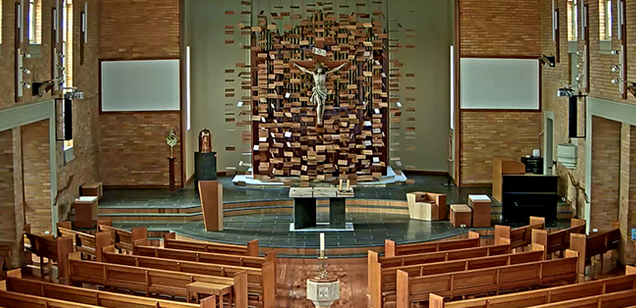
Although an organ behind the altar is quite common in European Baroque churches, it is normally placed high up so as not to compete visually with the altar, which in a Catholic church is supposed to be the focal point of the interior. Even when the “spirit of Vatican II” was at its full flood, it was rare to find a heritage-listed building treated with quite the same level of contempt for its architect’s intentions as St Vincent de Paul has been.
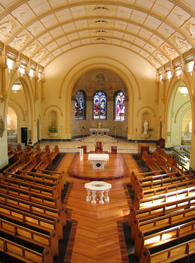 Then there is the Carmelite church in Middle Park, Melbourne, an exuberant 1927 brick and cement “blood and bandage” edifice in the neo-Romanesque style, the work of the prolific A.A. Fritsch. It recently acquired a favourite contrivance of Vatican II enthusiasts, a font, lectern and altar in a row down the middle of the nave (as pictured at right). There are now several other examples in Australia of this arrangement, which is supposed to emphasise the “balance” of “word and sacrament” but has the additional (deliberate?) advantage of leaving less space in the nave for pews so that diminished congregations don’t look so small. (At least at Middle Park the original fittings were left intact in the original sanctuary, thus respecting the “golden rule” of adapting historic buildings to contemporary requirements: if you must change things, do nothing irreversible.)
Then there is the Carmelite church in Middle Park, Melbourne, an exuberant 1927 brick and cement “blood and bandage” edifice in the neo-Romanesque style, the work of the prolific A.A. Fritsch. It recently acquired a favourite contrivance of Vatican II enthusiasts, a font, lectern and altar in a row down the middle of the nave (as pictured at right). There are now several other examples in Australia of this arrangement, which is supposed to emphasise the “balance” of “word and sacrament” but has the additional (deliberate?) advantage of leaving less space in the nave for pews so that diminished congregations don’t look so small. (At least at Middle Park the original fittings were left intact in the original sanctuary, thus respecting the “golden rule” of adapting historic buildings to contemporary requirements: if you must change things, do nothing irreversible.)
Radical changes to church buildings are not necessarily to be blamed on architects, who act on instructions, but can more often be laid at the door of a newish species of ecclesiastical “expert”, the “liturgist”, toiler in a vineyard of largely American invention. Before Vatican II there was no need for liturgists (there were liturgical scholars who studied the history and philosophy of liturgy, which is quite another thing) because the liturgy of the Mass and other rites and the specifications of the objects and furnishings required were fixed and determined by rubric. Many rubrics were dropped during Vatican II, giving the “liturgical consultant” of today the freedom to busy himself (or more often for some reason herself) with making liturgy more “relevant” and adapting the “liturgical environment”—that is, the church building—moving furniture around, installing overhead screens and dreaming up exercises in symbolism such as aquatic installations with water flowing out of fonts and over pebbles to indicate the “lifegiving spirit”. And it is from liturgists that a further indication has come that the spirit of wreckovation has not run out of steam, and that Australian churches are still at risk of “re-imagining”.
The Australian Catholic University in Melbourne has a “Centre for Liturgy” which last February arranged a symposium with the Catholic bishops’ National Liturgical Architecture and Art Board under the scriptural title of “Where Your Treasure Is, There Will Your Heart Be Also” (the precise application of which to church reordering seems obscure—perhaps they meant “Where Your Treasure Was …” for disgruntled donors of cast-out objects). Among the topics to be “explored” by what the website called “all those who care about the places of Catholic worship” was “the re-ordering of re-ordered churches”. This sounded promising, if what was meant was putting the churches back to the way they ought to be. Alas, that seems not to have been the intention at all.
For lo and behold, a “keynote speaker” invited to enlighten the assembled “clergy, parishioners, architects, artists, teachers, liturgists, designers” was the aforesaid Richard Vosko. Talk about looking to the past rather than the future. Vosko’s design philosophy goes back fifty years. He has been at the forefront of “spirit of Vatican II” reorderings for the half-century that has seen hundreds of American churches stripped of their fittings. Anyone interested in ecclesiastical design knows Vosko’s liturgical and theological principles backwards. If they are the inspiration for the “guidelines” promised by the February event it is hard to see how the symposium could hope to fulfil another of its stated purposes, that of ensuring that “damage is not done to the heritage value of our churches during any work undertaken to make them fit for sacred use”.
Nor are Vosko’s ideas sympathetic to one of the few growth areas in the contemporary Roman Catholic Church, that which is represented by the widespread re-introduction of the traditional Latin Mass, especially in the United States, and the emerging traditionalist constituency among the young.
But the traditionalist young are still relatively few in number and many of the old see nothing to object to in what might be termed the school of Richard Vosko. So it was hardly an encouraging start for the preservation or restoration of traditional church interiors in Australia (not only Catholic, since Anglicans and others often follow where Catholics lead) that the Australian Catholic University gave Vosko a further forum to expound his principles. Indeed, they need hardly have bothered, since when you think about it the kind of thing Vosko advocates is everywhere to be seen in this country already. It’s a case of si monumentum requiris circumspice, when the real challenge—the real future of church design, assuming churches have much of a future—is going to be undoing the damage and re-establishing a church architecture and design that recognises continuity rather than rupture and reconciles the best of the past with the new. What a pity Professor Stroik wasn’t invited.
As it happens, he might as well have been. By a pleasing irony, the news report in the Sydney Catholic Weekly (January 16, 2019) announcing the conference, complete with photograph of a (Brisbane) progressive parish’s emptied-out church (it looks like the concourse of a major railway station when the last train has gone) carries a link to a related article, “Timeless beauty has facelift at Lewisham”. Here, juxtaposed, we see the kind of thing the Voskoites would die a thousand deaths rather than countenance: a restored Puginesque interior with wall stencilling; high altar and reredos (and freestanding altar for flexibility), communion rails. The church, St Thomas Becket’s, is one of Sydney’s oldest. Its restorers, Edward O’Hanlon and QOH Design, have reminded contemporary liturgists and designers of what can be done when the past is imaginatively respected and interpreted according to its own aesthetic, historical and theological principles, something the Melbourne symposium did not exactly shout from the housetops.
Christopher Akehurst wrote on the Second Vatican Council (“Good Pope John and His Wonderful Idea”) in the October 2012 issue. He writes regular articles on church architecture for the Melbourne Catholic.
 Sign In
Sign In 0 Items (
0 Items ( Search
Search










If anyone would like to see a nicely-restored traditional Catholic church, St Patrick’s Church Hill (Sydney) is worth a visit. (Complete with plaster St Patrick, though no altar rails.) Plenty of masses in it too. Image gallery is here http://stpatschurchhill.org/image-gallery/
https://www.newsweek.com/ayaan-hirsi-alithe-global-war-christians-muslim-world-65817
You think Catholics have got problems! What about the vast barn-like auditoriums that are used in Pentecostal churches for Sunday services, complete with the obligatory stage for the performers – the rock-band they call a ‘worship team’. And this style of ‘worship’ is not confined to Pentecostals. Many protestant churches are mutilating beautiful traditional buildings to suit the new requirements. The organ is no longer used, so can be walled up, and neither are the choir-stalls, which can therefore be removed. Space has to be made for the drum kit, and the line-up of microphone-caressing starlets who ‘lead’ the ghastly proceedings.
The fundamental problem undoubtedly is the trashing of traditional liturgies, arising partly from pure ignorance as to their real significance and usefulness, and partly from a desire to make ‘church’ more like the sort of entertainment people are used to during the week. This is the exact opposite of what is actually needed, namely an environment that speaks of holiness and reverence – of separation from the jangle of the work-a-day world.
And it is not only church architecture that is at risk from this process of secularisation. The astonishingly rich heritage of church music is being trashed at the same time. Paradoxically, the only real hope for Christian music lies in the legions of under-employed classical musicians, who are driven by threatening penury to submit their unbelief to the scores and librettos of the great Catholic masses, and even the church cantatas of the J. S. Bach. There is something excruciatingly gruesome about attending performances of these works by people who have no idea what they are about or why they were created in the first place. But at least it keeps the musical tradition on life support – for the moment, anyway.